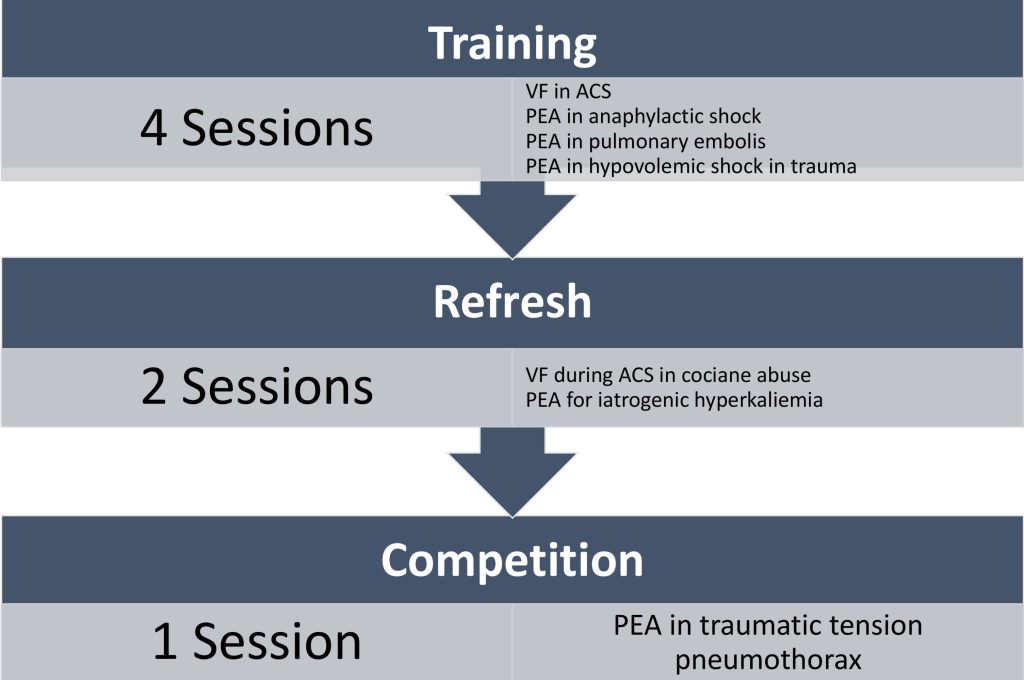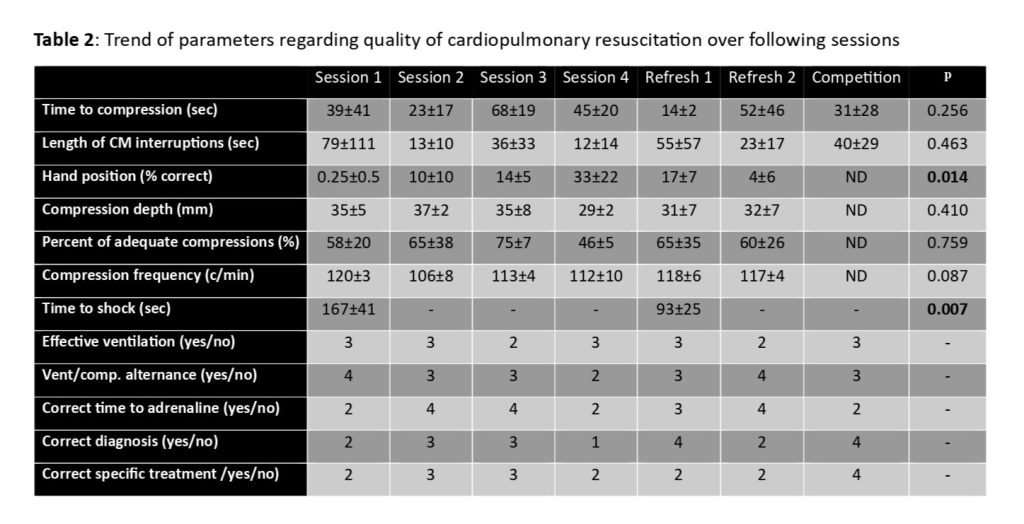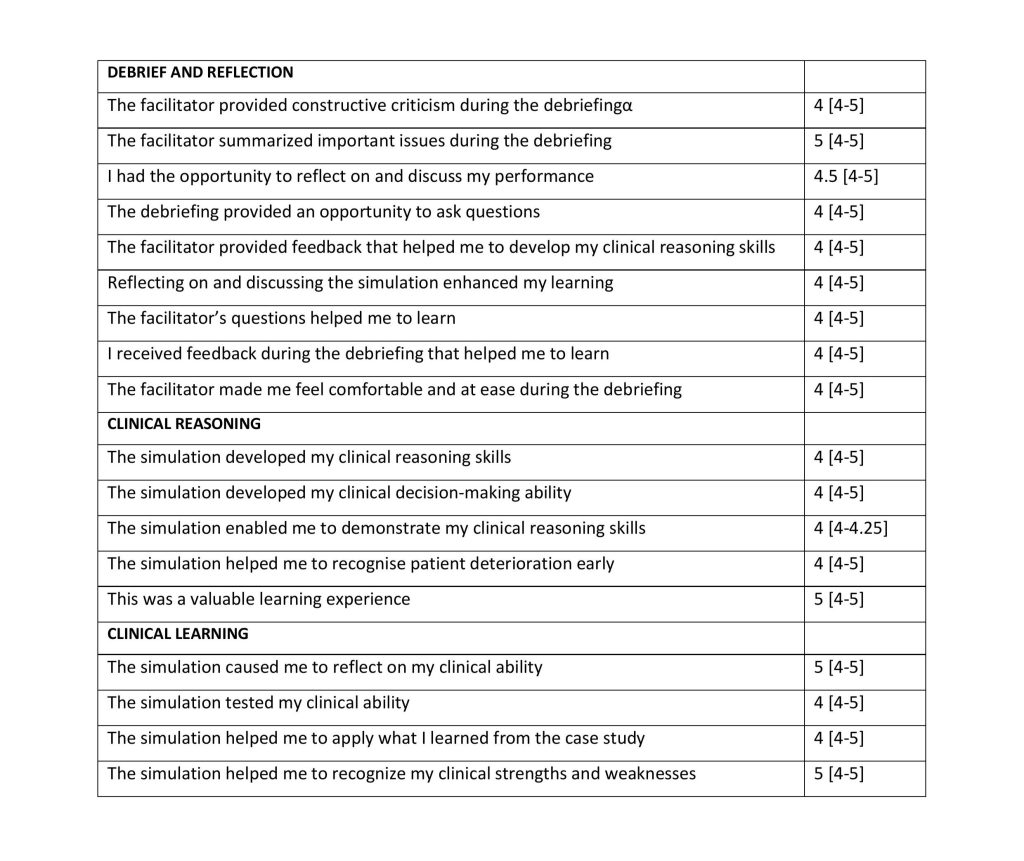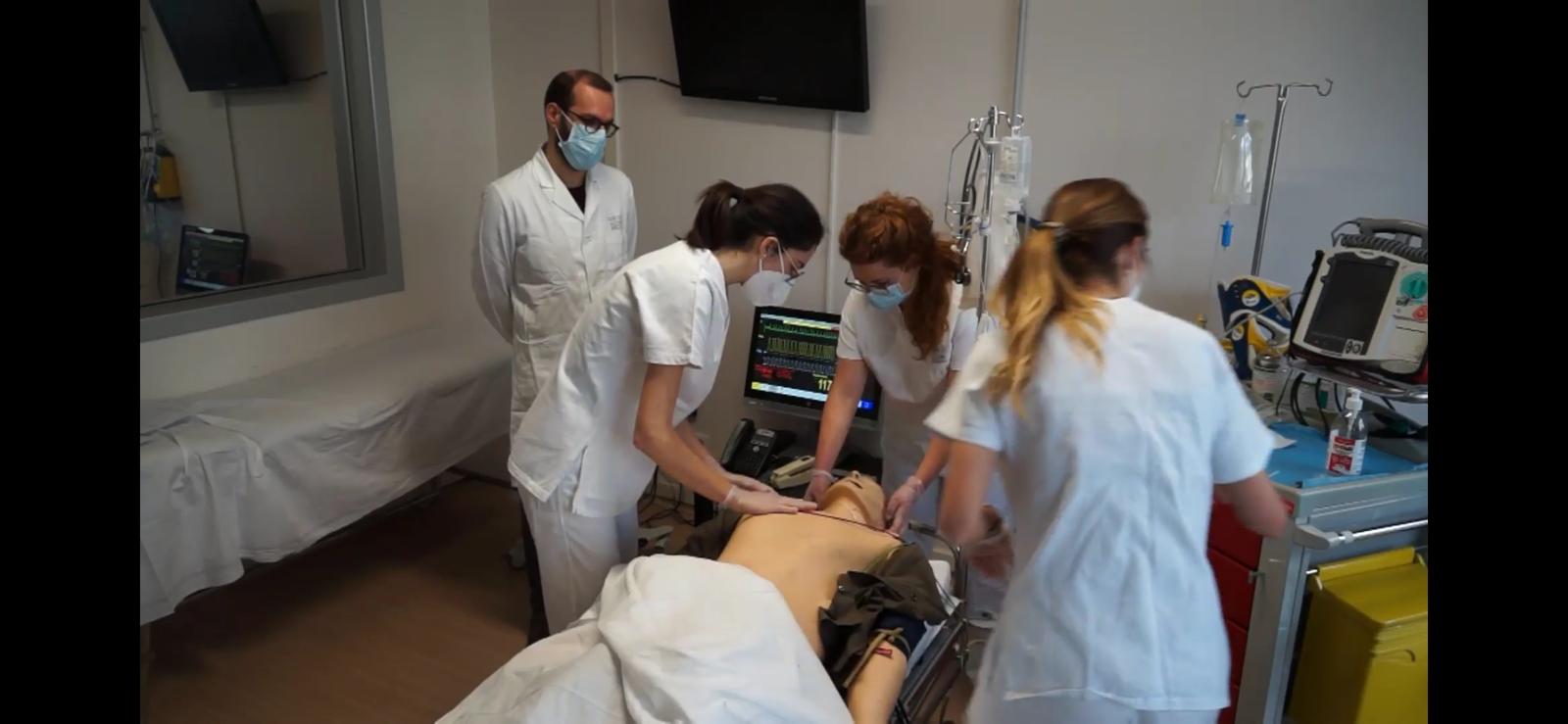This article explores the effectiveness of cardiac arrest simulation in medical education, particularly through high-fidelity simulation (HFS). By analyzing a recent training program for Emergency Medicine residents in the Università di Firenze, it highlights how simulation enhances both technical skills, such as CPR, and non-technical skills like teamwork. While notable improvements were observed in team performance and CPR timing, certain aspects like compression depth and differential diagnosis remained challenging. The article also discusses the trainees’ positive feedback and considers ways to further optimize the training process for better outcomes in real-life emergencies.
Introduction
High-fidelity simulation (HFS) is a training modality highly appreciated among students and residents. In fact, it allows hand-on learning, in a safe environment, without time constraints, where procedures and skills can be tested and retested, until reaching an adequate mastery (1). Moreover, it offers them the possibility to engage as leaders in managing critical situations, an event quite rare in the clinical arena, when the most experienced member often leads the team during crises (2). In past years, we already demonstrated that a simulation course including 7 sessions determined a significant improvement in residents’ Technical (TS) and Non-Technical Skills (NTS) (3).
Cardiac arrest: a paradigmatic clinical scenario
In 2023, during the training by High-fidelity Simulation of residents in Emergency Medicine of the Università di Firenze, we focused our attention on the management of the adult patient with cardiac arrest. In the presence of these clinical conditions, physicians are expected to apply an algorithm. It includes a clear sequence of TSs, most of which can be objectively assessed by the simulation system. Therefore, they are comparable between different scenarios, not left to the subjective judgment as other critical conditions, like cardiocirculatory shock or peri-arrest. Beside knowledge, an efficient teamwork performance is needed to complete all the required critical actions.
We evaluated that the clinical condition “cardiac arrest” could represent a paradigmatic situation, where we could test whether the use of HFS was effective to contemporary improve TS and NTS.
Our experience
What we did
Forty-eight residents, in their II and III year of the training program, who had already been exposed to simulation for 1 or 2 years, were divided into four groups for this study. Between March and September 2023, they performed 7 sessions, the first four on a weekly basis, two refresh sessions after three months and a simulation-based competition after 2 weeks. At the beginning of the program, all groups received a dedicated one-hour training about cardiopulmonary resuscitation. Each session included 3 scenarios about the management of critically ill patients, and, among them, there was always one scenario on cardiac arrest (Figure 1).

Scenarios were run according to a prespecified track and were followed by a structured debriefing, based on the Delta-Plus method. It offered the opportunity to reflect on the performance during simulation, focusing on the strengths of the team and on the possible improvements raised by the participants. During the debriefing, participants were also given a feed-back about their performance during CPR.
Trained observers rated both technical skills (TS) and non-technical skills (NTS) at the end of each scenario. TS were measured based on the feedback from the mannequin and the times measured by observers. NTS were evaluated using the Team Emergency Assessment Measure (TEAM) scale (4).
What were the results
As reported in the table below, ventilation-to-compression ratio, ventilation and compression frequency were applied correctly from the beginning; mean time to compressions was always shorter than 1 minute and the length of pauses decreased in following sessions. Significant deficiencies were observed in differential diagnosis and compression depth, which was good immediately after the training and worsened thereafter. TEAM score significantly improved between the first simulation and the final competition.

What the trainees perceived
In order to assess residents’ satisfaction towards this experience in simulation, we used the Italian version of the Simulation Experience Scale (SSES, Figure 5, part A), which was filled by all participants. Median values obtained in the different sections indicate that trainees were satisfied (debriefing 4.33, clinical reasoning 4.30, clinical learning 4.50), with a significant higher appreciation of the improvement in the area of clinical reasoning (p = 0.021, Figure 5, part B) than in the other ones.

An endless debate: is simulation really effective?
In this experience of training with HFS, participants demonstrated to master some important aspects of cardiopulmonary resuscitation, but did not improve significantly in those unsatisfactory from the beginning. Teamwork performance significantly improved and the trainees’ perception of the usefulness of HFS was definitively positive.
Role of simulation in medical education
Medical education is changing, due to the increasing complexity of the medical world, as well as for the evolving way of learning of the trainees (1, 5). Simulation is a learning modality usually appreciated by trainees, but its cost-effectiveness is not so favorable, both in terms of equipment, which is quite expensive, and personnel, due to a low ratio of trainees: facilitators. Therefore, demonstrating its effectiveness in the training process is of utmost importance. We can aim to reach different levels of competency by training in simulation. By the use of task-trainers, students and residents can learn the correct sequence of critical actions necessary to perform a given procedure (6, 7). The following steps may consist of the performance of the procedure in a multiprofessional team, the integration of the single procedure into the management of a clinical scenario and finally the ability to apply TS and NTS to the management of complex clinical scenarios (8-10).
Perspectives from our training program
With this training program, we consolidated the timely application of CPR and administration of medications, as well as the non-technical abilities of the team, while the quality of chest compressions and the ability to perform a correct and timely differential diagnosis improved less than expected (11, 12). On the other side, participants perceived a satisfying improvement in their clinical abilities.
Based on these results, we tried to figure out how to enhance the learning opportunities offered by simulation, to fill the most important gaps we evidenced. We highlighted the need to improve the technical performance in a procedure like cardiac massage, which influences the patient’s prognosis. Moreover, it has to be carried out while maintaining a global perspective, necessary to perform a wide differential, to identify the possible cause of the cardiac arrest.
A specific training, with the possibility to prolong the attempts until reaching a correct deep and velocity of compressions could address the inadequate performance of the cardiac massage, with the possibility to gradually integrate this technical skill in a more complex management of a clinical scenario. A personalized feedback both on technical and non-technical skills could improve the self-perception of the improvement.
Elisa Paolucci
Center for Advanced Simulation in Medicine, University Hospital Careggi, Florence, Italy
Anna De Paris
Center for Advanced Simulation in Medicine, University Hospital Careggi, Florence, Italy
Lorenzo Maiorano
Center for Advanced Simulation in Medicine, University Hospital Careggi, Florence, Italy
Rudy Marchetti
Center for Advanced Simulation in Medicine, University Hospital Careggi, Florence, Italy
Alessio Prota
Center for Advanced Simulation in Medicine, University Hospital Careggi, Florence, Italy
Antonio Annovi
Center for Advanced Simulation in Medicine, University Hospital Careggi, Florence, Italy
Adriana Gianno
Center for Advanced Simulation in Medicine, University Hospital Careggi, Florence, Italy
Elisa Capretti
Center for Advanced Simulation in Medicine, University Hospital Careggi, Florence, Italy
Francesca Innocenti
Center for Advanced Simulation in Medicine, University Hospital Careggi, Florence, Italy
REFERENCES
1. Guze PA. Using Technology to Meet the Challenges of Medical Education. Trans Am Clin Climatol Assoc. 2015;126:260-70. PubMed PMID: 26330687; PubMed Central PMCID: PMC4530721.
2. Morgan J, Green V, Blair J. Using simulation to prepare for clinical practice. Clin Teach. 2018;15(1):57-61. Epub 20170330. doi: 10.1111/tct.12631. PubMed PMID: 28371049.
3. Innocenti F, Tassinari I, Ralli ML, Bona A, Stefanone VT, Audisio R, et al. Improving technical and non-technical skills of emergency medicine residents through a program based on high-fidelity simulation. Intern Emerg Med. 2022;17(5):1471-80. Epub 20220218. doi: 10.1007/s11739-022-02940-y. PubMed PMID: 35181840.
4. Cooper S, Wakelam A. Leadership of resuscitation teams: “Lighthouse Leadership’. Resuscitation. 1999;42(1):27-45. doi: S0300-9572(99)00080-5 [pii].
5. Reed T, Pirotte M, McHugh M, Oh L, Lovett S, Hoyt AE, et al. Simulation-Based Mastery Learning Improves Medical Student Performance and Retention of Core Clinical Skills. Simulation in Healthcare-Journal of the Society for Simulation in Healthcare. 2016;11(3):173-80. doi: 10.1097/Sih.0000000000000154. PubMed PMID: WOS:000378021100004.
6. Seale J, Knoetze M, Phung A, Prior D, Butchers C. Commencing Technical Clinical Skills Training in the Early Stages of Medical Education: Exploring Student Views. Med Sci Educ. 2019;29(1):173-9. Epub 20181130. doi: 10.1007/s40670-018-00657-2. PubMed PMID: 34457465; PubMed Central PMCID: PMC8368689.
7. Yamazaki Y, Hiyamizu I, Joyner K, Otaki J, Abe Y. Assessment of blood pressure measurement skills in second-year medical students after ongoing simulation-based education and practice. Med Educ Online. 2021;26(1). doi: Artn 1841982 10.1080/10872981.2020.1841982. PubMed PMID: WOS:000583367900001.
8. Velásquez ST, Ferguson D, Lemke KC, Bland L, Ajtai R, Amezaga B, et al. Interprofessional communication in medical simulation: findings from a scoping review and implications for academic medicine. Bmc Medical Education. 2022;22(1). doi: ARTN 204 10.1186/s12909-022-03226-9. PubMed PMID: WOS:000773955800002.
9. Seligman L, Abdullahi A, Teherani A, Hauer KE. From Grading to Assessment for Learning: A Qualitative Study of Student Perceptions Surrounding Elimination of Core Clerkship Grades and Enhanced Formative Feedback. Teach Learn Med. 2021;33(3):314-25. doi: 10.1080/10401334.2020.1847654. PubMed PMID: WOS:000591750400001.
10. Lovink A, Groenier M, van der Niet A, Miedema H, Rethans JJ. The contribution of simulated patients to meaningful student learning. Perspect Med Educ. 2021;10(6):341-6. Epub 20211012. doi: 10.1007/s40037-021-00684-7. PubMed PMID: 34637120; PubMed Central PMCID: PMC8633349.
11. Anderson TM, Secrest K, Krein SL, Schildhouse R, Guetterman TC, Harrod M, et al. Best Practices for Education and Training of Resuscitation Teams for In-Hospital Cardiac Arrest. Circ Cardiovasc Qual Outcomes. 2021;14(12):e008587. Epub 20211115. doi: 10.1161/CIRCOUTCOMES.121.008587. PubMed PMID: 34779653; PubMed Central PMCID: PMC8759032.12. Hunziker S, Johansson AC, Tschan F, Semmer NK, Rock L, Howell MD, et al. Teamwork and leadership in cardiopulmonary resuscitation. J Am Coll Cardiol. 2011;57(24):2381-8. doi: 10.1016/j.jacc.2011.03.017. PubMed PMID: 21658557.
READ ALSO









































